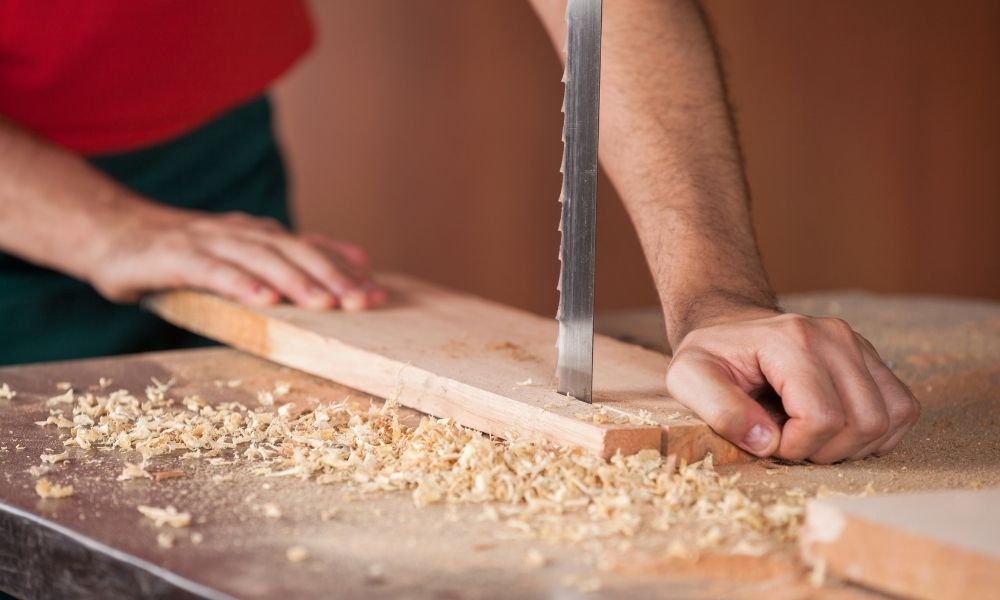If you’ve ever used a bandsaw, you might have noticed that the blade sometimes has a mind of its own. It doesn’t always stay on the straight and narrow, and that can be quite frustrating. So, why does a bandsaw blade wander? Let’s find out!
You see, a bandsaw blade has teeth that do the cutting as they move through the material. But sometimes, these teeth can get off track, causing the blade to veer off course. It’s like a mischievous little adventure for the blade!
There are a few reasons why a bandsaw blade might wander. It could be due to improper blade tension, dull or damaged teeth, or even the choice of the wrong blade for the material you’re cutting. Curious to know more? Let’s dive deeper into the fascinating world of bandsaw blades!

Why Does Bandsaw Blade Wander?: Solving the Dilemma
Welcome to our comprehensive guide on why bandsaw blades wander! In this article, we’ll explore the various factors that can cause a bandsaw blade to deviate from its intended path and how you can address this issue. Whether you’re a woodworking enthusiast or a professional carpenter, understanding why bandsaw blades wander is crucial for achieving accurate cuts and maximizing the performance of your bandsaw. So, let’s dive in and unravel the mysteries behind this common bandsaw problem!
Factors that Contribute to Bandsaw Blade Wander
When it comes to bandsaw blade wander, there’s a multitude of factors that can play a role in causing this frustrating issue. Let’s take a closer look at some of the primary culprits:
Blade Tension
One of the most common causes of bandsaw blade wander is improper blade tension. When the blade is either too loose or too tight, it can lead to the blade drifting off course during cutting. To ensure the correct tension, consult your bandsaw’s manual or follow industry guidelines that suggest applying the appropriate tension for the specific blade width and material you’re working with.
Additionally, regular maintenance and checking the tension on your bandsaw blade are crucial. Over time, blades can loosen or become stretched, potentially leading to wandering. Routinely inspect your bandsaw blades and make any necessary adjustments to maintain optimal tension.
If you notice that the blade is consistently wandering, especially after tension adjustments, it may be worth considering the quality and condition of the blade itself. A dull or damaged blade can impact its ability to track accurately, so sharpening or replacing the blade might be necessary.
Blade Guides
Another factor to consider is the quality and alignment of your bandsaw’s blade guides. The blade guides are designed to keep the blade in the proper position during cutting and prevent it from wandering. If the guides are worn, improperly set, or misaligned, they can contribute to blade drift.
To address this issue, inspect your blade guides regularly and ensure they are properly adjusted and lubricated. Pay particular attention to the side guides and thrust bearings, as they have a direct impact on the blade’s stability. By maintaining and aligning your blade guides correctly, you can minimize blade wander and achieve more precise cuts.
Blade Tracking
Proper blade tracking is crucial for preventing wandering. Blade tracking refers to the alignment of the blade in relation to the bandsaw’s wheels. If the blade is not aligned correctly, it can cause the blade to veer off course and wander during cutting.
To ensure proper tracking, start by adjusting the position of the blade on the bandsaw wheels. The blade should be centered and run smoothly along the face of the tires. Check your bandsaw’s manual for specific instructions on how to adjust the blade tracking properly.
In addition to blade placement, make sure the bandsaw wheels are in good condition. Worn or damaged wheels can impact the blade’s tracking ability, leading to wandering. Inspect the wheels regularly and replace them if necessary.
Material Characteristics
It’s essential to consider the type and characteristics of the material you’re cutting when addressing bandsaw blade wander. Different materials can pose unique challenges and require adjustments in cutting techniques or blade selection.
For example, dense or oily woods may require a specific blade with more aggressive tooth geometry to prevent wandering. Similarly, metalworking applications may necessitate specialized blades designed to withstand the rigors of cutting through metal.
Understanding the properties of the material you’re working with and selecting the appropriate blade for the job can significantly reduce wandering and improve the overall cutting experience.
Key Takeaways: Why Does Bandsaw Blade Wander?
- 1. Blade tension may not be properly adjusted.
- 2. Poor quality blade causing excessive vibration.
- 3. Incorrect blade tracking adjustments.
- 4. Dull blade or improper tooth configuration.
- 5. Feeding the material too fast or unevenly.
Frequently Asked Questions
Are you wondering why your bandsaw blade tends to wander during use? We have answers to your questions on this common issue.
1. How can I prevent my bandsaw blade from wandering?
To prevent your bandsaw blade from wandering, there are a few things you can try. First, make sure the blade tension is properly set. If the tension is too loose, the blade may wander off course. Additionally, ensure that the blade guides and bearings are adjusted correctly, as improper alignment can lead to drifting. Lastly, check that your bandsaw’s table is flat and in good condition, as a warped or damaged table can also cause the blade to wander. By addressing these factors, you can minimize blade wandering and improve the accuracy of your cuts.
2. Why does the bandsaw blade wander to one side?
One common reason for bandsaw blade wandering to one side is incorrect blade tracking. Blade tracking refers to the alignment of the blade on the wheels. If the blade is not properly centered on the wheels, it can cause drifting to one side. Check the blade tracking by carefully adjusting the tension and using the tracking adjustment knobs or screws provided on your bandsaw. Another potential cause could be uneven tooth set or damage on one side of the blade. This can also lead to the blade veering off course. Inspect the blade for any issues and replace it if necessary.
3. Can a dull blade cause wandering?
Yes, a dull blade can contribute to wandering. When a blade is dull, it becomes less effective at cutting, leading to increased friction and heat. This heat can cause the blade to warp and drift off track, resulting in wandering. It’s essential to regularly inspect your bandsaw blade for signs of dullness or wear. If you notice any dull or damaged teeth, it’s recommended to replace the blade to ensure optimal cutting performance.
4. Will using the wrong blade width affect wandering?
Using the wrong blade width for your bandsaw can indeed affect blade wandering. When the blade is too wide for the material being cut, it can lead to increased resistance and drifting. On the other hand, if the blade is too narrow, it may struggle to maintain a straight path, causing it to veer off course. It’s crucial to match the blade width with the material you are cutting to ensure smoother and more accurate cuts, minimizing wandering.
5. Why does feed rate play a role in blade wandering?
The feed rate, or how fast you push the material through the bandsaw, can impact blade wandering. If you feed too quickly, the blade may struggle to keep up with the material, resulting in wandering. On the contrary, feeding too slowly can cause the blade to cut unevenly, leading to similar issues. Finding the right balance is key. Experiment with different feed rates to discover the optimal speed that allows the blade to cut smoothly without wandering.

Summary
Sometimes a bandsaw blade can wander when you are cutting wood. There are three reasons why this happens. First, the blade might be dull, so make sure to keep it sharp. Second, the blade tension could be too low, so adjust it properly. Lastly, the blade’s guides may not be set correctly, so adjust them too. By following these simple steps, you can prevent your bandsaw blade from wandering and improve your cutting results.
In conclusion, a dull blade, low tension, and incorrect guides can cause a bandsaw blade to wander. Keep your blade sharp, adjust the tension properly, and set the guides correctly to ensure clean and accurate cuts. Remember, practice makes perfect, so don’t be discouraged if it takes a few tries to get it right!
